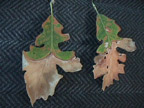Most
Common Tree Diseases
|
| 
|
Apple
Scab
An
early season fungal disease that affects most crabapple in the
landscape, particularly the last few years. Only two preventive
sprays are necessary for excellent control. The health of a chronically
infected tree can suffer greatly from this easily controlled leaf
disease. |
|
 |
Ash Anthracnose
As
a fungal disease that causes stunting, distortion and browning
of emerging leaves. Spraying for control can be difficult due
to the size of ash trees. Cultural practices like fertilization,
mulching, and proper pruning can counteract the effects of anthracnose.
More
on Fertilization... |
|
 |
Rhizosphaera
This
fungal disease is often the cause of death for immature blue spruce
trees. Control is difficult and requires a long-term commitment
to a treatment program. Planting less susceptible native conifers
reduces the impact of Rhizosphaera. |
|
 |
Dutch Elm Disease
The
most devastating tree disease to date, killing nearly every elm
tree in the midwest. Mature elms that remain need to be protected
by injections paired with the prompt removal of diseased trees
(sanitation). More
on Dutch Elm Disease;
Injections in general...
|
|
 |
Oak Wilt
This
disease is caused by a fungus that is lethal to all native oak
trees. The symptoms, treatment options, and recommendations vary
depending on the species and site conditions. In white and bur
oaks, this disease can be difficult to diagnose. More
on injections... |
|
 |
Oak Anthracnose
This
leaf disease is mainly an aesthetic problem whose control is complicated
by the size of oak trees. Where the necessary spring sprays to
control anthracnose aren't feasible, mulching, fertilizing and
proper pruning should be done to maintain the vitality of mature
oaks. More
on Fertilization... |
|
 |
Diplodia
This
fungal disease, also known as Spharopsis, is common to stressed
pines. The death of new shoots are an obvious symptom of infection.
Recommendations vary depending on the severity of infection, health
of the tree, and site conditions. |
|
 |
Dothistroma
Dothistroma
causes the discoloration and loss of needles to stressed pines
in the landscape, particularly red and Austrian pine. A commitment
to treatment is necessary to achieve adequate control. |
|
 |
Fire Blight
A
damaging bacterial disease affecting many landscape plants, mostly
mountain ash, hawthorn, and apples. Foliage and small branches
turn brown to black and branch cankers appear sunken. The lone
control method is pruning to remove diseased limbs and cankers
during dormancy. |
|
 |
Cytospora Canker
Cytospora
canker is a disease that attacks spruce from the bottom up, causing
needle loss and branch death. Infected branches exude conspicuous
amounts of white resin. Removing infected limbs slows disease
progression. There is no existing chemical control. Fertilization,
mulch, and proper watering make a tree less susceptible to an
infection. More
on Fertilization... |
|
We
strive for control of insects and disease, not elimination. This
allows us to serve you in the most cost-effective, environmentally
sound manner |

